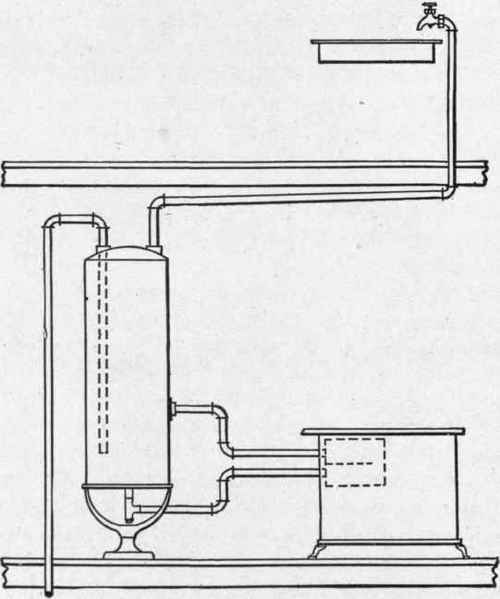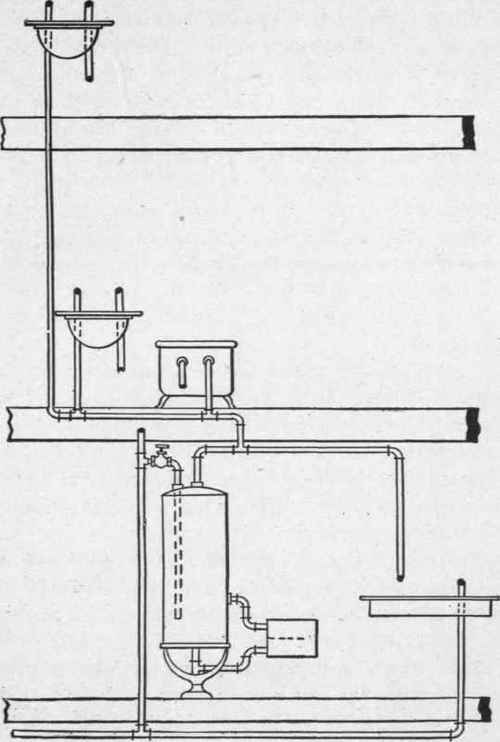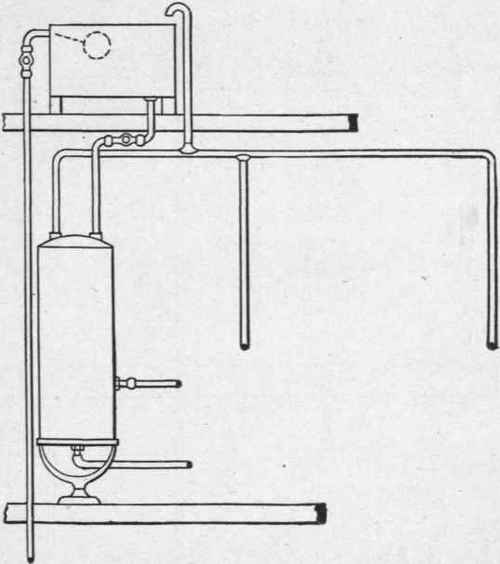Hot Water Plumbing
Description
This section is from the book "Practical Up-To-Date Plumbing", by George B. Clow. Also available from Amazon: Practical Up-To-Date Plumbing.
Hot Water Plumbing
As the drawings shown in the article on Hot Water Supply are merely diagramatic outlines of the different systems and are only intended to illustrate the principle of the circulation, which is involved in the heating of water for domestic use, further description and additional drawings are here given to illustrate the two systems of water heating in common use, viz.: the pressure-cylinder system and the gravity-supply tank and cylinder system.
In Fig. 29 is shown one of the simplest arrangements of the pressure-cylinder system for the successful heating of water for household use. The boiler, water-back and pipe connections are all plainly shown. In the boiler is a pipe extending down from the top and connected with the cold water supply, which it discharges in the boiler a short distance from the bottom. The distance down in the boiler which this pipe should extend depends upon the height that the pipe from the upper part of the water-back enters the boiler. The cold water supply should always enter the boiler at a considerable distance below the point of entrance of the pipe conveying the hot water from the water-back to the boiler.
The greater the distance that the hot and cold water pipes are apart in the boiler, the better will be the circulation and the less time it will take to heat a given amount of water.

Fig. 29.
The piping in the arrangement shown in Fig. 29 is designed to deliver hot water on the floor above that on which the boiler is located. If hot water is desired on the same floor a connection can be made in the pipe leading from the top of the boiler to the faucet on the floor above.

Pig. 30.
Fig. 30 shows an arrangement of fixtures and piping to supply hot water on three floors by the pressure-cylinder system. Hot water is supplied to the kitchen sink on the ground floor, to a bath tub and wash bowl on the second floor and to a wash bowl on the third floor. The cold water supply pipe to the boiler is shown and the cold water connection to the kitchen sink, while the cold water pipes to the bath tub and wash bowls on the upper floors are omitted for the sake of simplicity.
Fig. 31 shows one of the simplest forms of the gravity-supply tank and cylinder systems, in which the boiler, water-back and hot water connections are all on the same floor. The cold water pipe goes to the floor above or to the attic as the case may be to the supply tank, where the supply of water is regulated by a ball float cock. An expansion pipe as shown should be provided in the hot water pipe leading from the boiler and arranged to discharge into the supply tank. In Fig. 32 a gravity-supply tank and cylinder system is shown, which is arranged to deliver hot water to the kitchen sink and also to a bath tub and wash bowl on the floor above. The cold water pipe is shown running up to the supply tank and also to the kitchen sink. For the sake of clearness and to avoid confusion the cold water pipes leading to the wash bowl and bath tub are omitted.
It must be remembered that the kitchen boiler is not a heater, it is simply a reservoir to keep a supply of hot water on hand so that it may be drawn when required. By this arrangement hot water may be had long after the fire has been extinguished in the stove, as it stores itself by the law of gravitation at the upper part of the boiler, and is forced out by cold water entering below and remaining there without mingling with or cooling the hot water in the upper part of the boiler. It should be understood that the natural course of hot water, when confined in a boiler and depending for its motion on the difference between its temperature and the temperature of other water in the same boiler, is in a perpendicular or vertical direction. And consequently when the heating apparatus or pipes which have to convey the hot water from the water back to a boiler in which the hot water is to be stored in any position other than in a vertical position, friction is added which retards the flow of hot water just in proportion to the degree of angle from the vertical of the hot water pipes.

Fig. 31.

Fig. 32.
A noise in the pipes and water-back, and also a rumbling noise in the boiler indicates that there is something wrong, and which requires attention. These noises are produced by different causes, sometimes on account of the way the upper pipe from the water-back in the stove is connected to the boiler.
This pipe should always have some elevation from the water-back to where it enters the boiler. The more elevation the better the water will circulate. But the slightest rise in this pipe will make a satisfactory job. It should be a continuous rise if possible, the entire length from the water-back to the boiler.
Another cause of this noise comes from the water-back being filled, or nearly so, with scale, which partly stops the water from circulating. Nearly all the troubles of this kind come from a bad circulation of water between the stove and boiler. If the trouble is allowed to continue very long without doing anything to improve it, it will grow worse, and perhaps stop up entirely. With the connections between the water-back in the stove and the boiler stopped up, what is to be expected? With a good fire in the stove under these conditions, an explosion of the water-back, which may blow the stove to pieces and, perhaps, kill some of the occupants of the house. There are two conditions of things that will cause the water-back in a stove to explode. First, to have water in the water-back with its outlets or pipe connections stopped up, then have a fire started in the stove. The fire will generate steam in the water-back, and, having no outlet through which the steam might escape, an explosion must take place. The second way through which the water-back could explode is to have no water in the kitchen boiler, with a good fire in the stove and the water-back red-hot, then allow the water to be turned on suddenly into the boiler and water-back. Under these conditions steam would be generated faster than it could escape through the small pipe connections, and would naturally result in an explosion.
The different ways of connecting a water-back on any water heating device to an ordinary kitchen boiler, are governed, to some extent, by the conditions in each individual case.

Fig. 33.
In connecting a gas-heated water device, the connections should be made as shown in Fig. 33, which is known as a top connection, the particular reason being that it is possible, with a connection of this kind, to heat small quantities of water and to heat it quickly, and water can be drawn within five minutes after lighting the gas the great advantage being the economy of fuel and time. A gas-heated water device should always be connected to a flue.

Fig. 34.

Fig. 35.
When connecting a kitchen boiler to a water-back in a range, the connection should be made as shown in Fig. 34. As the range fire will probably be kept burning all day, the question of fuel economy is not to be considered - the advantage of a connection of this kind is that it gives a large body of water from which to draw at all times.

Fig. 36.
Connections to vertical and horizontal boilers, when connected to independent water heaters are shown in Figs. 35 and 36.
Another device recently put on the market and shown in Fig. 37, is a combination reservoir and heater. This heater is unique in construction of water compartments inasmuch as all surfaces are exposed very advantageously to the flame. The central water compartment being directly over the flame and the pipe which carries hot water to the top of the tank enables it to supply hot water within a very short time. The gas supply is regulated by a thermostat, which automatically decreases the flow of gas when water is heated and automatically increases the flow of gas as soon as the hot water is drawn from the tank. Two clusters of blue flame gas burners, which are independent of each other, and can be used separately or both at the same time, furnish the heating medium. The advantage of this boiler, outside of the economy of fuel consumption, is that it requires little space for the installation and a great saving in the piping. Again the automatic gas regulating feature prevents the boiler from becoming over-heated and from its subsequent dangers, as the temperature of water is maintained at about 170 degrees Fahrenheit.


Fig. 37.
In the sectional cut a steam coil is shown whereby the water can be heated with steam, in case it is installed, where steam is available.
Continue to:


